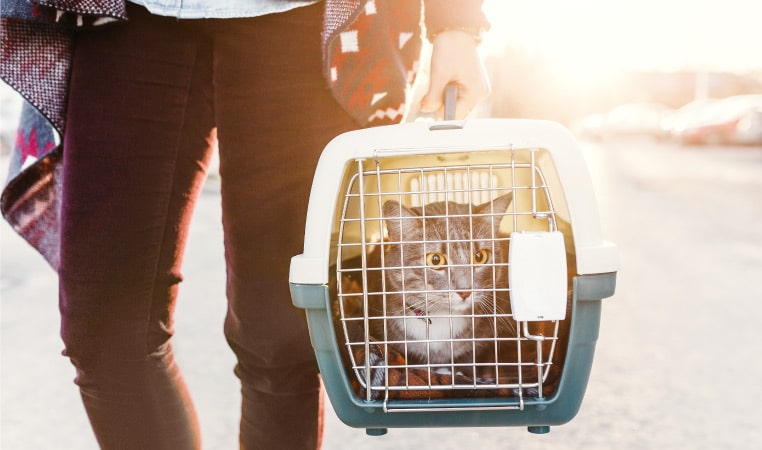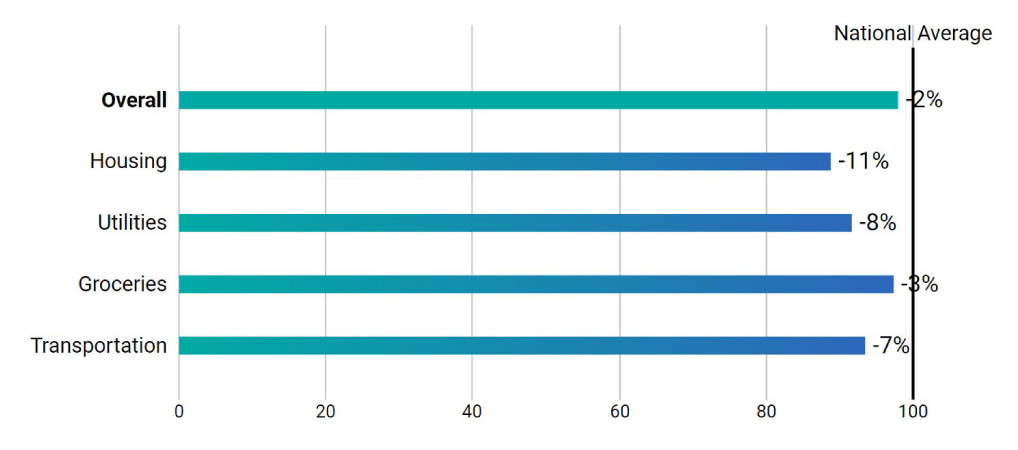
Moving With Cats? It’s Totally Paw-ssible With These 12 Purr-fect Tips
Moving is already a stressful time. But when you start the process of moving with cats, things can become very complicated. Regardless of if you’re moving across the country or a few states over, it’s important to consider your feline family members before the chaos of moving begins.
Whether it’s prepping things to fly or getting the car ready for a cross-country venture, there are steps you can take to make the entire experience easier on everyone. We’re here with 12 of the best tips for moving with cats to help you get started.
Where to Start When Moving With Cats
Besides preparing ahead of time with the tips we’re about to share, it’s important to know the common signs of cat anxiety and how you can keep an eye on your pet throughout the moving process.
Whether it’s physical signs like coat changes or a distressing one, like destroying things or going outside the litter box, it’s important to know how to handle these symptoms.
| Q: How do I move my cat cross-country and stay sane? A: The best way to do this is with proper planning and preparation. Start by getting updated records and a comfortable carrier. The further in advance you can gather these things, the easier it’s going to be for your entire household to get to your next home. |
1. Get Vet Visits and Vaccinations Out of the Way
The best way to be proactive and handle any odd symptoms you notice is to take your cat to the vet. They’ll be able to update your cat’s vaccines, as well as treat the symptoms they’re experiencing.
For the trip itself, they might suggest a mild sedative or anxiety relief medication to help make travel less stressful. It may put them to sleep or help them relax enough to not be restless in their carrier, ensuring your cat can stay calm throughout the duration of the trip.

2. Register Microchips
When moving long-distance with cats, it’s essential to have them microchipped — and to not forget to register those microchips online. This information will typically include your name, your pet’s name, physical address, and your telephone number.
If your cat gets lost anywhere along the way and gets taken to a vet or shelter, the first thing they’ll do is scan their microchip. Besides a collar, this is, by far, the easiest way for anyone to contact you.
3. Decide How You’ll Be Traveling
Once you know they’re healthy and safe, it’s time to decide how you’ll be traveling together. The most common ways are by plane or car. Both come with their pros and cons, so it’s important to consider your cat and their unique needs before making your final decision.
| Q: Is it better to fly or drive a cat across country? A: The short answer: It depends. Flying is louder, but it’s faster than driving and gets things over more quickly for the both of you. If your cat is healthy, then it might save a lot of stress. However, if you have a senior cat or feel like taking your time while driving would be less scary for them and you, this can often be easier and less stressful, though not as fast. |

Flying With Your Feline
Flying successfully with your cat begins long before you venture to the airport. You’ll need to plan ahead and prepare to not only relieve anxiety but to also make the experience as easy as possible for both of you. Here are a few things you can keep in mind for the trip.
4. Stay Together When Possible
The first thing you should check is whether or not your cat can travel in-cabin with you. Your cat can’t have a seat of their own, but they can stay in their carrier under the seat in front of you. Each airline has specific weight requirements, as well as crate dimensions, that you’ll have to abide by, though. You’ll also need to ensure you have the proper paperwork prepared. Here are a few things you might need:
- Health certificate or a certificate of veterinary inspection
- Vaccination records
- Any necessary medication documents
Most of these documents can only be given by a licensed veterinarian, so it’s essential to schedule an appointment well ahead of your flight.
In some cases, your cat might not be able to fly in the cabin. If this is the case, they’ll have to go in the plane’s cargo hold. Opinions over pets traveling this way vary, but having them in the cabin with you is undoubtedly the best option, so it’s important to find an airline that can accommodate them.
5. Know How to Move Through Security
The important thing to know is that your cat will have to come out of their carrier when they get to the TSA checkpoint. They can’t go in the x-ray tunnel, so you’ll have to carry them through with you.
If you know your cat has a tendency to run, it might be best to place them on a leash so they can’t escape while you go through the metal detector. Some airports offer private rooms for pet security checks, but these aren’t always guaranteed. Be sure to ask once you reach the security checkpoint, though.
6. Get a Good Carrier
For both flying and driving, you’ll need to get a good carrier. For cars, though, it’s especially important. Without the proper security, your cat can wander anywhere, including under the pedals, in front of the dashboard, or even on your steering wheel — all of which are potentially dangerous spots. If they’re not secure, they can also bolt out the door.
It’s important to get a carrier that your cat can feel safe and comfortable in throughout the entire ride. That means one that’s dark and cozy but still big enough for them to stand, sit, and turn around comfortably in. It should also be able to accommodate food and water bowls and a towel or blanket at the bottom to help keep them from slipping throughout the ride.
Also, if you’re moving with multiple cats, it’s best to keep them separate during the ride. That means purchasing each pet their own carrier.
If you can, it’s also a great idea to get your cat used to driving. Take them out for small trips as often as possible leading up to the move. You’re a lot more likely to find they’re not as anxious when it’s time to head to your new home.

Making the Drive
Moving long-distance with cats might be stressful, but taking the extra time to drive can be a beneficial experience. It’s quieter than the airport, and you have more control over their environment. You don’t have to take them out of their crate at a strange security checkpoint, and you can stop every few hours to give them access to water and their litter box.
What other things will you need to consider, though?
7. Get Them Used to Their Carrier
Prepping your carrier begins, ideally, a few months before you and your cat move. You can save yourself and your cat a headache by turning their carrier into a destination kitties dream of. Leave their carrier, door open, near their favorite spots in the house. Make it soft, warm, and comfortable, and consider keeping their food and water bowls in it. If your cat is used to being in their carrier, and even better, if they love being in it, travel will be a breeze.
It’s best to help them associate their carrier with positive experiences, so allowing them to have personal time inside it before you leave can make a huge difference throughout the travel process.
| Q: How do I prepare my cat for a cross-country move? A: Get your cat as used to traveling as possible. Leave their carrier out a few weeks ahead of your move and allow them to explore it. If you’re driving, be sure to take them on short rides leading up to moving day. If you’re flying, taking them on small walks can help relieve anxiety around their carrier, making it a lot easier on the both of you once the time comes to travel. |
8. Pull Together Travel Essentials
Once you have their carrier, it’s time to pull their travel essentials together. Here are some of the most important items you’ll need on hand:
- Paperwork
- Food
- Water
- Leash and harness/collar
- Toys
- Travel bowls
- Travel litter box
- Bags of litter
- Items with familiar scents
9. Find Pet-Friendly Accommodations
If your drive is long enough, you’ll also need to consider pet-friendly hotels along the way. It’s important to time your trip right if you have to give them medications, as you’ll be able to stop at your hotel once they’re feeling restless after things start to wear off.
Having items with a familiar scent is very helpful in new places, as they give your cat a sense of comfort that only home can provide. Blankets, pillows, and other soft items that carry scents of home well are ideal.
This is also why helping them get comfortable with their carrier is essential. They’ll have a place to retreat when they’re feeling overwhelmed, and they’ll be less likely to hide in a spot you won’t be able to find them in later.
| Q: What is the best way to transport cats long distance? A: Your best travel options depend on your cat. If they’re healthy and handle stress well, traveling by plane might be a great option. It will help you both reach the destination quickly and be home faster, but that’s not always the answer. Driving is a better option for cats who don’t deal well with stress or have health conditions. If you still aren’t able to answer this question on your own, though, it’s best to speak with your vet. |

Top Tips (No Matter How You Travel)
10. Trust the Pros
No matter how you’re traveling, moving with PODS can help keep your furry family members happy and comfortable the entire time. The PODS container will carry your things, while you and your cat drive or fly to your destination.
You won’t have to worry about towing a big rental truck or trailer. And you don’t have to worry about your cat getting lost in the shuffle of movers coming in and out of your home. With PODS, your moving and storage container will be delivered straight to your driveway. You’ll have plenty of time to pack, load, and then do it all over again once you’re at your new home. Having the benefit of packing things up on your own time, at your own pace, removes a lot of the stress that your pet might otherwise feel throughout the process. That means more time to get settled in and less stress for Whiskers.
11. Keep Things Calm
Remember, your cat takes emotional cues from you. During times of stress, you’re the one they look to for comfort and reassurance. They’re more attuned with your emotions than you might think, so it’s important to keep this in mind when you’re preparing for long-distance moving with cats. Luckily, there are things you can do to help your cat acclimate, no matter how you’re traveling.
The best thing is to act normal and take everything slow. There are things they’ll be stressed about no matter what, but remaining calm and working to give them a stress-free environment throughout the moving process can make a big difference in how the process carries out.
| Q: How do you travel 12 hours with a cat? A: The best thing you can do for your cat during long-distance travel is to keep things as quiet as possible for them. This can be difficult in an airport or on an airplane, but staying calm lets them know they’re safe. If you begin to panic or stress, they’re going to do the same. |
12. Plan Ahead
The absolute best thing you can do for them is plan ahead. If you don’t already have one, establishing a routine is a great idea for keeping things calm. Stick to their current routine before you leave and once you arrive at your new home. This is going to help them know what to expect in a new environment, and they’re more likely to acclimate well.
Once you arrive at your new home, have a designated space for them to come out and get settled. It can feel like you need to give your cat constant attention to ensure they’re okay when you move to a new home, but that isn’t always the case. Your feline is a social creature, but they also get overwhelmed and might need a quiet place to acclimate. The bathroom is a great place to help keep them safe while still giving them space. There aren’t a lot of objects for them to ruin if they’re upset, and there are still hiding places they can utilize if they need it. Be sure to have things set up for them before they’re out of their crate, and then remember that they might need that quiet time. Once they seem used to the bathroom, you can start introducing them to one room at a time. Letting them roam the house can seem like a good idea, but they’re likely to find a hiding spot that you weren’t even aware of at that point. Waiting until they’re used to a certain space is the best way to help keep them safe.
| Q: Can you move cross-country with a cat? A: You can absolutely move cross-country with a cat. It might sound like a complicated process, but with the right planning, preparation, and help by your side, getting your feline family member to their new home is a cinch. |
Want more moving advice? Check out the rest of the PODS Blog.
Katlynn Mullins is a St. Petersburg-based freelance writer whose only roommate is their cat. A frequent PODS Blog contributor, Katlynn loves finding ways to make moving into new spaces simple and stress-free. Between yearly apartment hopping, you can find them on the waterfront or experimenting with new ways to make coffee.
Comments
Leave a Comment
Your email address will not be published. Required fields are marked *
